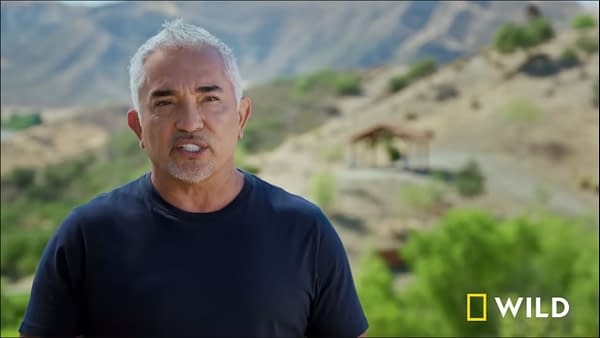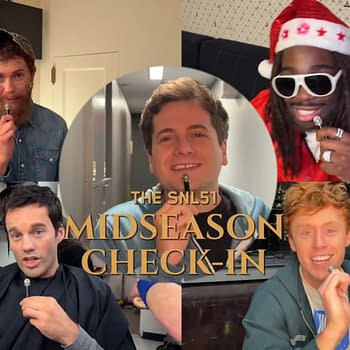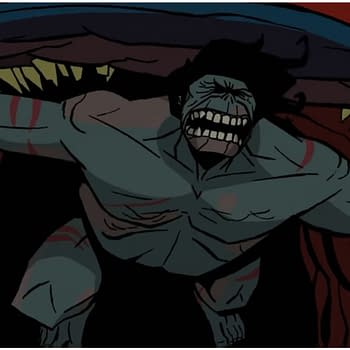Posted in: Disney+, Hulu, streaming, TV | Tagged: Cesar Millan, Cesar Millan: Better Human Better Dog, NatGeo, National Geographic, south park, The Dog Whisperer
Cesar Millan on Longevity, Biggest Dog Challenge, South Park & More
Cesar Millan (Better Human, Better Dog) spoke with us about his years on TV, his biggest dog challenge, the "South Park" aftermath, and more.
Cesar Millan has been a pioneer in dog training, showing American audiences how to become better pet parents for over 20 years through his hosted TV shows like Discovery's The Dog Whisperer, National Geographic's Better Human, Better Dog, and various media appearances. The formula remains the same: assess the dog and its parent's temperament and environment and retrain both accordingly. His success has even caught the eye of South Park creators Matt Stone and Trey Parker, accurately portraying his mannerisms and training in the Season 10 episode "Tsst" (the sound Millan makes to discipline a dog), which involves a fictionalized version of the personality to use on the unruly and sociopathic Eric Cartman (Parker) to temporary success. Millan spoke with Bleeding Cool about his longevity on television, if pet owners evolved, if he's had to refine his techniques if parents like South Park's Liane Cartman (April Stewart) have approached him to retrain them and their children, and the benefits of his co-founded Halo Dog Collar.

Cesar Millan on Helping Americans Become Better Dog Parents
Bleeding Cool: What are the biggest lessons you learned in your 20 years of television?
Fate, repetitions, passion, and creativity, because I am telling a country that loves a dog more than any other country in the world, "Don't forget about exercise. Don't forget about challenging the mind. Exercise, discipline, affection." This is what it takes to become an Olympian: Exercise. Discipline. Affection. Dog people had a habit before I came to America, which was affection, affection, affection, right? People said, "I have a big backyard. Why do I have to take my dog for a walk?" It was a lot of bad habits that America had before I came and I needed to break through it in an honest, respectful, loving, and smart way so people don't fight. People say, "Well, that makes sense, right?" That definitely is something that I needed to come from having: men of honor, men of respect, men of passion, and men of creativity just to change a bad habit without telling people they're doing it. They're doing it wrong or bad about what they're doing, but I needed to trigger that part of the American people.
Have you felt pet culture has evolved over the years, and what has that taught you as a behaviorist?
People are more compassionate and have more empathy. They are becoming more respectful because, for a while, people say, "My dog is my baby," That's good for you, but the dog grew up fast from birth to eight months; he's a puppy. Eight months and three years is another lesson and three to eight as an adult. The dog needs to grow up, so you must grow up with him. You must live, not just the story so people allow the reality to be experienced and avert life and death. Nobody wants the dog to die, but then I must help people.
When this passes, only the body is gone. The spirit is still here, the heart is still here, and the memories are still here. They didn't want to let go of this story, and if you don't let go, you're not living the reality. The dog senses that you're tense and sad and that something inside makes you worry. I must help people to let go and to surrender, to allow whatever life is at that moment; that's what it is. That's when I can teach. I exercise discipline, affection, rules, limitations, trash bag love, follow, play, and explore. It's not the dog; it is you. I had to remove the story, and it took a while, and now people are doing the reality. As you can see, if you watch social media, a lot of behavior is everywhere. Everybody wants to be "The Dog Whisperer," and so they see it as a beautiful profession. They can make a difference in people's lives.
How do you feel your techniques have evolved, with dogs and for people over the years?
I break it down for people a lot easier. "This is a leash, okay? This is a halter, okay? This is a harness, okay? This is a backpack. These are boots." I show people how this tool works or how this philosophy can be applied to a dog that is in a fearful state versus one in an aggressive state and one in an avoidant state. This is fight-or-flight avoidance. You need a different technique for each mind, right? Most importantly, you must comprehend why we must do that and why we need to use this tool. Why it took this long is easier to rehabilitate an aggressive dog than a fearful dog. Why? Because a fearful dog, you need to build self-esteem. With an aggressive dog, you redirect the aggression, and you tell them, "Hey, do agility and do search and rescue. Hey, let's go for a bike ride. Let's go on rollerblades." You're redirecting energy. A dog that is doing avoidance is not motivated and not inspired by you. Okay, let me show you how to do it when you apply the toys. A technique needs to be given to the state of mind that that dog is in.
Has there been a case on 'The Dog Whisperer' or 'Better Human, Better Dog' that stood out to you? Is it easier to have that short memory or a clean slate between clients?
It's a clean slate because I never worked with them. Your home has a different energy than somebody else's home. You have a different energy than somebody else. Your dog is absorbing the energy of the house. I helped so many people who gave me the wisdom of patience, silence, and creativity. Those three things are very important and that you can only gain with time. One of the most amazing pieces I ever worked on in my life is a dog named Brunello. This guy became aggressive, but nothing wrong with aggression because I have done aggression for practically 20 years. This guy is blind and deaf and has a neurological problem. I never worked with a dog who is blind, deaf, has a neurological problem, and is aggressive. Normally, they don't become aggressive when they're blind, right? They relied on somebody to guide them, but this guy became extremely aggressive. I had to use my patience, silence, and creativity to help this dog who was blind, deaf, had a neurological problem, and had been aggressive for six years. This is one of the cases on 'Better Human, Better Dog,' and this is what makes me me. This is what makes Cesar Millan, Cesar Millan, and this is what some people are going to say, "Okay, now I understand this guy." It's easier to work with a dog where its eyes and ears are fine. You can redirect them. He can see and hear you, but [Brunello] can't see or hear you. There's something wrong with his brain because he's a puppy mill dog, and he's aggressive. It's four things against this dog.
I saw your reaction video on the 'South Park' episode 'Tsst,' and it's as instructional as your other content. Have you ever been approached by parents about helping them with their children?
I do a lot of talks with teachers. I created a Mutt-i-grees curriculum with Yale University where I was sitting with teachers because when you're in a group in front of kids, it's a pack of kids, and you need to assess and evaluate what kids are going to give you trouble, right? How do I do that with dogs when all the teachers say we do the same? It's about energy, philosophy, and action. The only difference between a kid and a dog is the way they learn; a dog learns nose, eyes, and ears, and a kid learns ears, eyes, and nose. When you were a kid, you needed somebody with the right energy, philosophy, and actions, right? You call that teacher, coach, or parent, and then the actions and activities are the same. Exercise and mental stimulation affect your body, mind, and heart. The only thing that changes is how you learn because you are a human with ears, eyes, and nose, and a dog with nose, eyes, and ears.
How does the Halo Dog Collar help dog parents?
It helps parents maintain the dog within the rules, boundaries, and limitations. For example, if you're not at home and don't want the dog to go into the kitchen or bedroom or bark at the window so your neighbors don't complain, the tool will remind the dog not to do it, right? If you want to go outside and don't want the dog to go too far away, the Halo Collar will remind them of the boundaries. If your dog is playing with another dog and you're done, you can use the whistle part of the tool, and it brings the dog back to you. That's the limits, rules, boundaries, and limitations. It is going to help people maintain consistency and structure so the dog, you can say, is well-behaved, and the reason why it behaves well is because it's consistent with the rules, boundaries, and limitations. You are consistent with the activities that a dog needs, which is to follow you to play and to explore, follow, play, and explore.
Cesar Millan: Better Human, Better Dog airs Fridays on National Geographic and is available to stream on Disney+ and Hulu.
















